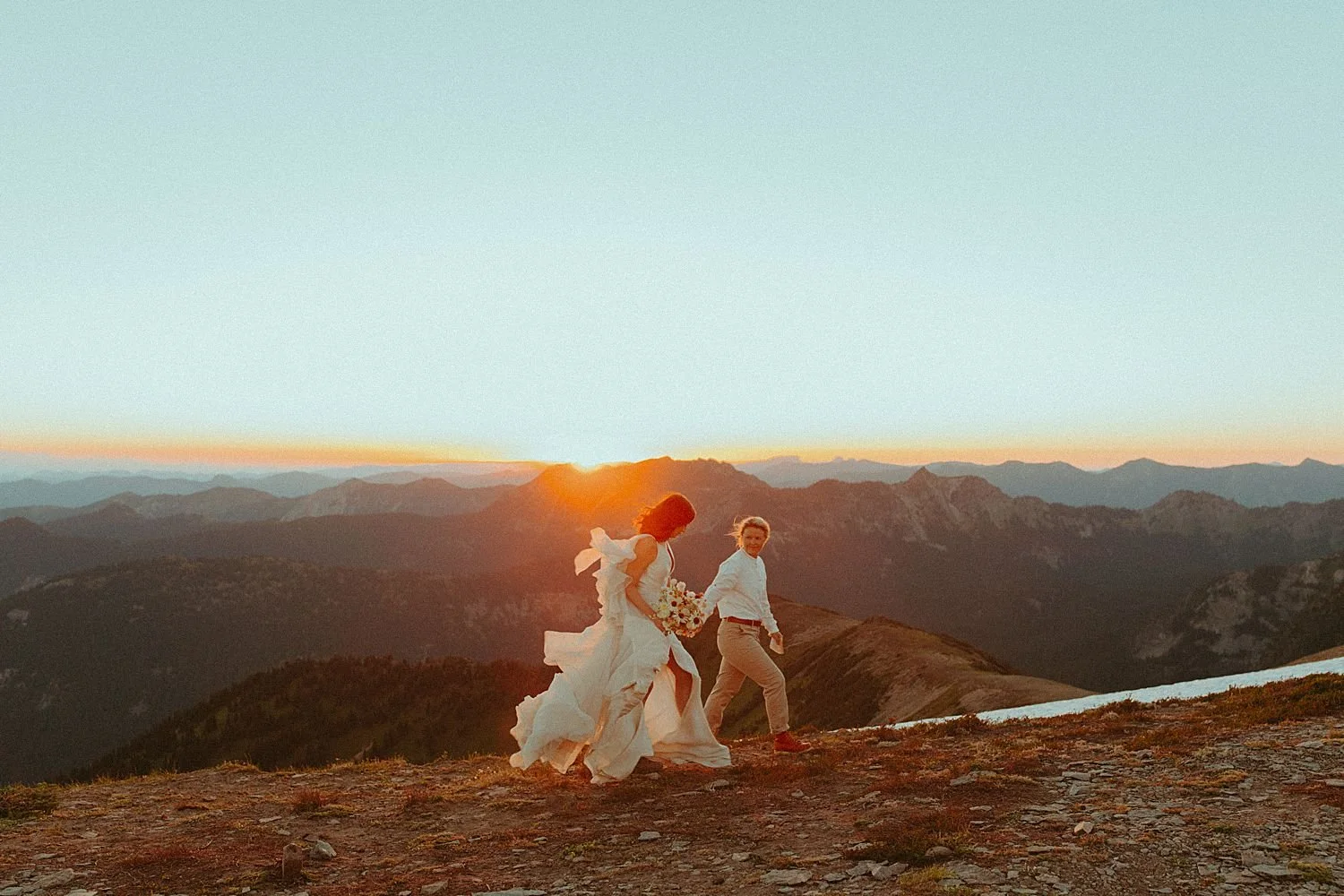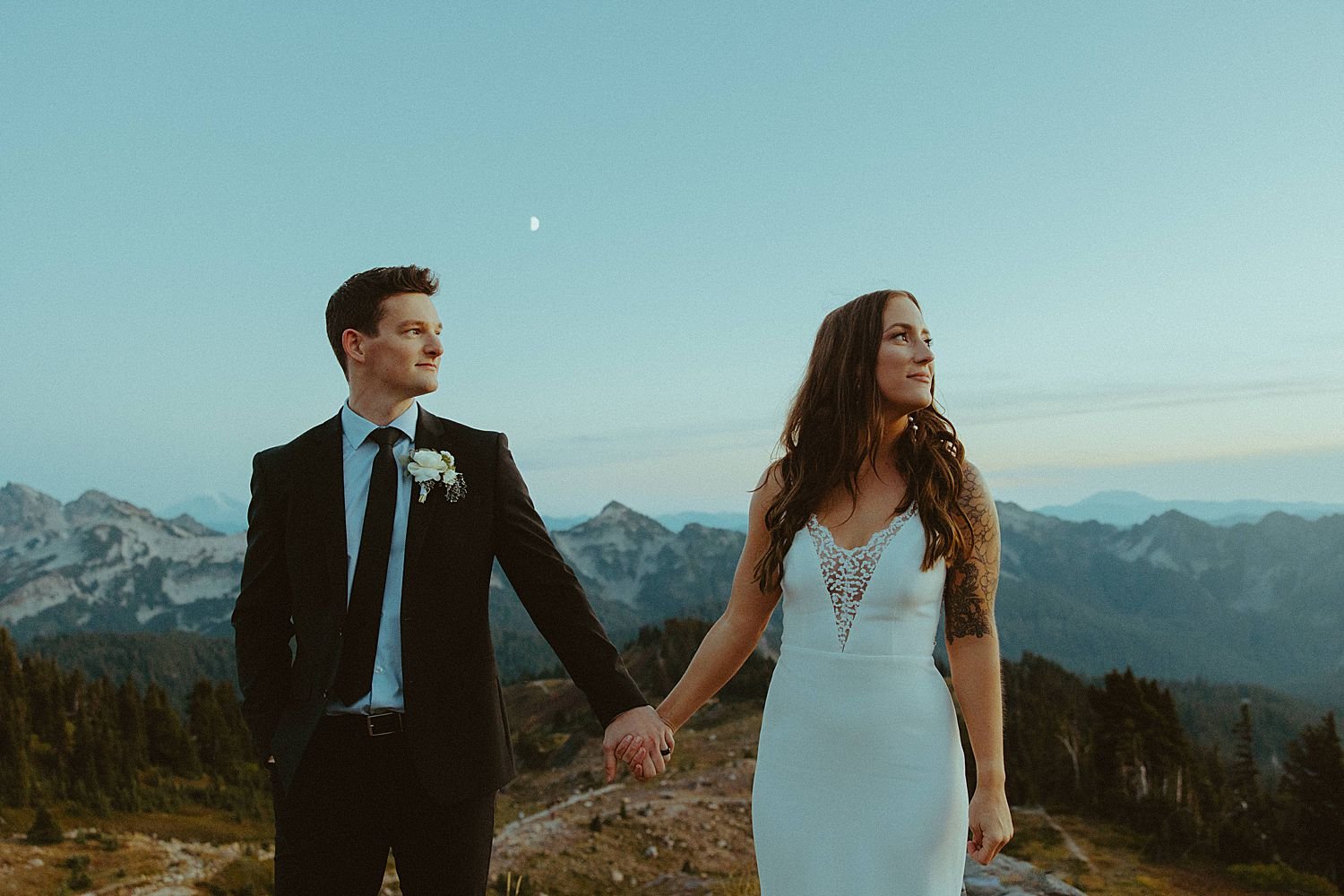Mount Rainier National Park Elopement Guide
Eloping at Mt. Rainier
Mount Rainier is a beautiful and iconic mountain located in the Pacific Northwest region of the United States. It is the highest mountain in the state of Washington, standing at 14,411 feet tall and an active stratovolcano, which means it is a conical volcano formed from layers of ash and lava. In the summer months, the mountain is a popular destination for hikers, climbers, and nature enthusiasts.
Why I love it here:
Wildflowers: In general, the wildflower season at the park begins in late June and lasts through early September. Here is a breakdown of when you can expect to see different types of wildflowers at the park:
Late June to early July: You can expect to see a variety of early blooming flowers, such as lupines, paintbrush, and alpine daisies.
Mid-July to early August: This is the peak of the wildflower season at the park, and you can expect to see a wide variety of flowers in bloom, including heather, aster, and gentian.
Late August to early September: This is the tail end of the wildflower season at the park, and you can expect to see late-blooming flowers such as asters, goldenrod, and fireweed.
Wildlife: The mountain is also home to an array of wildlife, including bears, mountain goats, and elk. Both black bears and grizzly bears can be found in the park, although grizzly bears are much less common. Be sure to follow proper bear safety guidelines while hiking in the park. Mountain goats - These majestic animals can often be seen on the rocky cliffs and slopes of the mountain. During the summer months, elk can be found grazing in the meadows and forests of the park. The park is home to many different species of birds, including eagles, ospreys, and peregrine falcons. You may also see smaller animals such as marmots, chipmunks, and squirrels while exploring the park.
Epic views: Lush meadows, pristine trails, 360 mountain views, beautiful sunsets, and more.
The summer months are the busiest time of year at Mount Rainier National Park, with crowds flocking to the mountain to take in the stunning views and enjoy the warm weather. The park is open from sunrise to sunset, and offers a variety of ranger-led activities and guided tours. Whether you're an experienced hiker or just looking to take in the beauty of the mountain, Mount Rainier is a must-visit destination in the summer months.
How to Get There:
There are a few different ways to get to the park.
Fly: The closest major airport to Mount Rainier National Park is Seattle-Tacoma International Airport (SEA). From there, you can rent a car.
Drive: If you are coming from Seattle, you can reach the park by taking Route 7 south to Route 12, then turning left onto Route 410. The park is about a 2-hour drive from Seattle. Or if you are coming from Portland it’s about a 2.5 hour drive.
Take the bus: The Mount Rainier National Park Shuttle operates from June to October and offers service from the towns of Ashford, Elbe, and Packwood to the park.
Take the train: The Amtrak Cascades train service offers service from Portland and Seattle to the town of Tacoma, which is about an hour's drive from the park. From Tacoma, you can rent a car or use a ride-sharing service to reach the park.
Weather and Seasons
Mount Rainier National Park is located in the Pacific Northwest region of the United States, which means it experiences a variety of weather conditions throughout the year. In general, the weather at Mount Rainier is cooler and wetter than in other parts of the country, with average summer temperatures ranging from the low 50s to the mid-70s and average winter temperatures ranging from the mid-30s to the low 40s.
The park receives the most rain in the winter months, with December, January, and February being the wettest months. The summer months are generally drier, but it is still a good idea to come prepared for rain and cooler temperatures, as the weather can change quickly on the mountain.
The best time to visit Mount Rainier National Park depends on what you are hoping to do. If you want to enjoy the park's many hiking and climbing opportunities, the summer months (June through September) are generally the best time to visit, as the trails are typically snow-free and the weather is milder. This is when I recommend planning your shoot or elopement. If you enjoy skiing or snowshoeing, the winter months (December through February) can be a great time to visit the park.
How to Elope in Mount Rainier National Park
To get married at Mount Rainier National Park, you will need to obtain a special use permit and follow the park's guidelines for weddings. Here are the steps you need to follow:
Contact the park to check availability and to request a special use permit application. You can do this by calling the park at (360) 569-6575 or by sending an email to mora_special_use@nps.gov.
Fill out the special use permit application and submit it along with the required fee to the park. The park will review your application and let you know if it has been approved.
Once your application has been approved, you will need to make arrangements for your ceremony. This may include hiring an officiant, renting any necessary equipment (such as chairs or a sound system), and coordinating with any other vendors you may be using (such as a photographer or florist).
Hold your ceremony at the park, following all park rules and guidelines. Be sure to clean up any debris or decorations after the ceremony.
Obtain a marriage license from the county in which the ceremony will take place. You will need to present this license to the officiant before the ceremony can take place.
There is a $175 application fee for the permit that you should apply for at least 4 weeks beforehand. Depending on if you’re bringing guests (and the number of guests) may limit you to holding your ceremony in certain areas or on certain trails. Modest decorations are allowed, but chairs, tents, and the throwing of confetti or any other item is not allowed.
Planning Process: 6 Easy Steps to Plan Your Elopement
Planning a Mount Rainier elopement can be a beautiful and intimate way to celebrate your love.
Choose the time of year you’d like to get married based on the season.
Contact the park to check availability and to request a special use permit.
Choose a location for your ceremony. Mount Rainier National Park has many beautiful locations for an elopement, including meadows, forests, and lookout points.
Make arrangements for your ceremony. This may include hiring an officiant, renting any necessary equipment (such as chairs or a sound system), and coordinating with any other vendors you may be using (such as a photographer or florist).
Obtain a marriage license from the county in which the ceremony will take place. You will need to present this license to the officiant before the ceremony can take place.
Hold your ceremony at the park, following all park rules and guidelines. Be sure to clean up any debris or decorations after the ceremony.
Best Hikes at Mount Rainier
Mount Rainier National Park is home to a variety of beautiful and challenging hikes, ranging from easy walks to strenuous backcountry treks.
Skyline Trail - This 7.2-mile loop hike offers stunning views of the mountain and the surrounding landscape. The trail begins at the Paradise Visitor Center and follows the ridge of the mountain, passing by several lookout points and ending at the Paradise Inn.
Mystic Lake Loop - This 7.8-mile loop hike takes you through a beautiful old-growth forest and past several sparkling lakes. The trail begins at the Mystic Lake Trailhead and follows the Wonderland Trail, passing by Mystic and Mystic Lake before returning to the trailhead.
Tolmie Peak Trail - This 5.6 mile moderate-hard hike is a very popular trail, and for good reason. With epic mountain, lake, and Ridgeline views you’ll love the journey. At the end there’s a fire lookout with amazing views.
Mount Fremont Lookout Trail - This 5.4-mile round-trip hike takes you to an old fire lookout with breathtaking views of the mountain and the surrounding landscape. The trail begins at the Sunrise Visitor Center and follows a steep, rocky path to the lookout.
Spray Park Trail - This 8.2-mile round-trip hike takes you through a beautiful alpine meadow filled with wildflowers and small waterfalls. The trail begins at the Mowich Lake Trailhead and follows a steep path to the meadow.
Naches Peak Trail - This 3.3 mile easy-moderate loop hike takes you through gorgeous alpine meadows filled with wildflowers and offers views of the mountain and an alpine lake.
Fire Lookouts
The park does have a few fire lookouts that are popular with visitors, including:
These lookouts offer stunning views of the mountain and the surrounding landscape. If you're interested in visiting one of these lookouts, I recommend checking the park's website for more information on directions, accessibility, and any seasonal closures.
What to Pack
Here are a few things you should consider packing for a day in the park:
Waterproof jacket or raincoat - The weather at Mount Rainier can be unpredictable, so it's a good idea to bring a waterproof jacket or raincoat to stay dry in case of rain.
Layered clothing - The temperature can vary significantly on the mountain, so it's important to bring layers that you can add or remove as needed.
Hiking shoes or boots - Good hiking shoes or boots are essential for exploring the park's trails. Look for shoes with good grip and support to keep you comfortable and safe.
Sun protection - The sun can be intense at high elevations, so don't forget to bring sunscreen, a hat, and sunglasses to protect yourself from UV rays.
Snacks and water - It's important to stay hydrated and nourished while exploring the park. Pack plenty of water and bring some snacks to keep your energy levels up.
Maps and a first-aid kit - It's a good idea to bring a map of the park and a first-aid kit in case of any emergencies.
















A magical PNW summer elopement at Mount Rainier, surrounded by their closest family and friends.